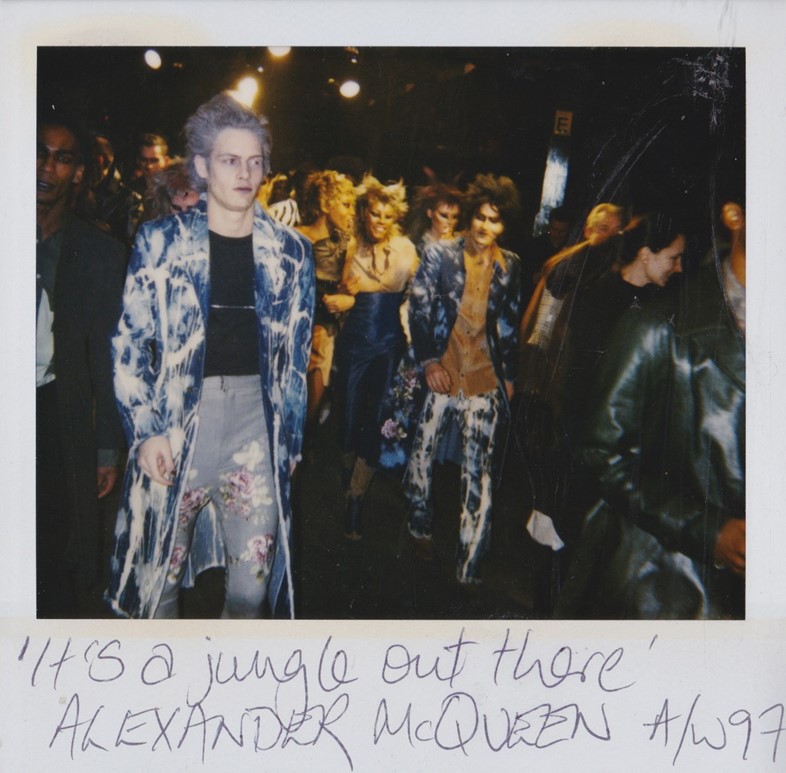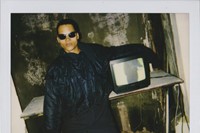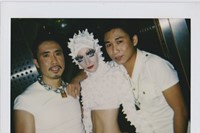Mark C. O’Flaherty captured the likes of Leigh Bowery, Princess Julia and Boy George
London’s nightlife scene is in turmoil, tarnished by unreasonable licensing laws, bad mainstream music and soaring prices where the cost of a few vodka cokes could equate to a mini-break in Berlin. But back when we were just ringing in the 90s, misfit Meccas like The Haçienda and Kinki Gerlinki were providing Britain’s youth with some of their finest after-dark experiences; spaces where lifelong friendships were formed, inhibitions were unheard of, and a subsequent four-day hangover was the norm. The best part is – Mark C. O’Flaherty was there to capture it.
“There was one day when I was working at a magazine and I slept under the editor’s desk all day because I was so fucking tired,” exclaims O’Flaherty, who spent his youth immortalising iconic club nights via his candid Polaroid snaps. “You’d never get away with that now!”
O’Flaherty started photographing nights out while he was studying film at the School of Communication near London’s Oxford Circus. His inner-city education meant that he spent much of his free time in nearby Soho, where the 1980s hangover kickstarted a longing for nightlife that lived up to Leigh Bowery’s Taboo and the iconic club night Blitz. Thankfully nightlife icons Michael and Gerlinde Costiff started Kinki Gerlinki, a hotbed for London’s self-proclaimed art and fashion freaks which was frequented by the likes of Leigh Bowery, Princess Julia and Boy George. “The first time I went to Kinki Gerlinki, I was the very first in the queue and I remember they didn’t let me in for over an hour and half because you were not welcome unless you were on the guestlist,” O’Flaherty explains. “It wasn’t a club for civilians, it was just for friends.”

After making friends and acquaintances, the photographer found himself as a guestlist regular and a firm fixture on club scenes around the world. Despite the access, he still felt like an outsider, so he utilised his camera skills as a means for communicating with his thrill-seeking counterparts. “Even though I was really dressed up, I didn’t think that was enough of a reason for me to be interesting. Everyone loves their picture being taken – less so now, because there’s no currency in it – but if you had a camera in a nightclub back then, you were contributing to the culture.” Whether it was Manchester’s Haçienda or New York’s Jackie 60, O’Flaherty could be found on the dance among club-goers with his Polaroid instant, capturing anything and everything that attracted the focus of his lens. The result of his picture-taking is candid snapshots into the lives of some of the world’s most iconic figures: Grace Jones taking a moment of peace at the side of the dance floor; Leigh Bowery showcasing his magnificent fashion creations; Susanne Bartsch laughing alongside Gerlinde Costiff. All nightlife icons captured in their most honest moments.

O’Flaherty admits that he hadn’t forgotten about these photographs until now – he simply hadn’t showcased them before because it still seemed so recent. Looking at them today he says he sees a more interesting time, when people were less obsessed with the internet and actually had to go out to communicate. “It also reminds me of a period when people were experimenting,” he tells me. “Clubs were changing because drugs were happening in a very new way. Ecstasy took over everything in London during that time, cocaine was the big thing in New York, and looking at those pictures, I’m very immersed in taking a lot of drugs...”

After spending his own adolescence rubbing shoulders with the Blitz Kids and making memories and firm friends with the likes of Alexander McQueen, can O’Flaherty pinpoint his most memorable night out? “There was one coach trip to The Haçienda that was amazing,” he shares. “Manchester had a far more advanced and sophisticated gay scene than London, the club culture was much more articulated. We got on a coach with Leigh Bowery and Michael [Costiff] and all the club kids and it was fantastic. I remember the coach going back was late and Gerlinde [Costiff] was screaming ‘MY PEOPLE ARE BEYOND ENTERTAINMENT, THEY NEED TO GO HOME!’ I just loved her so much, she was like a mum and she just wanted everyone to have fun. When we finally got back to London we went straight into college and then, of course, we started all over again in the afternoon.”

As the 90s roared on, club kid culture became less prolific, making way for boilersuits and acid house; camera -hones and in-house photographers offering key-rings took the currency away from club-night candids. Despite the societal shift and rebirth of the UK nightlife scene, O’Flaherty still believes that there are places worth going to today, and that in 20 years time today’s clubbing generation will be saying “wow, weren’t things so much better back then!” With that in mind, O’Flaherty exclaims: “I would LOVE to go out in that era again. It was fucking incredible.”






